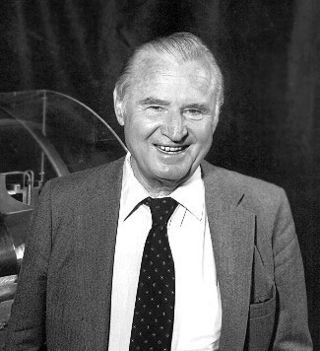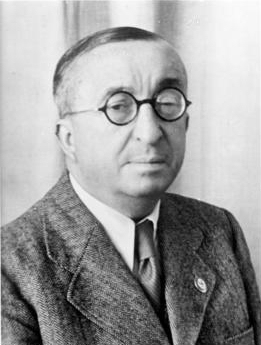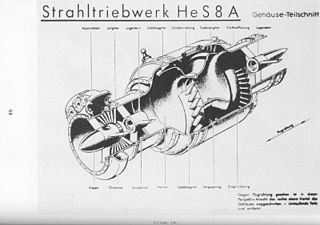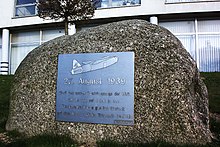
A jet engine is a type of reaction engine, discharging a fast-moving jet of heated gas that generates thrust by jet propulsion. While this broad definition may include rocket, water jet, and hybrid propulsion, the term jet engine typically refers to an internal combustion air-breathing jet engine such as a turbojet, turbofan, ramjet, pulse jet, or scramjet. In general, jet engines are internal combustion engines.

A jet aircraft is an aircraft propelled by one or more jet engines.

The turbojet is an airbreathing jet engine which is typically used in aircraft. It consists of a gas turbine with a propelling nozzle. The gas turbine has an air inlet which includes inlet guide vanes, a compressor, a combustion chamber, and a turbine. The compressed air from the compressor is heated by burning fuel in the combustion chamber and then allowed to expand through the turbine. The turbine exhaust is then expanded in the propelling nozzle where it is accelerated to high speed to provide thrust. Two engineers, Frank Whittle in the United Kingdom and Hans von Ohain in Germany, developed the concept independently into practical engines during the late 1930s.

Hans Joachim Pabst von Ohain was a German physicist, engineer, and the designer of the first turbojet engine to power an aircraft. Together with Frank Whittle he has been described as the co-inventor of the turbojet engine however, the historical timelines show that von Ohain was still a university student when in January 1930, Whittle filed his first patent for a turbojet engine and Whittle successfully ran his first engine in April 1937, some 6 months before von Ohain. Additionally, prior to designing engine and filing his own patent in 1935, von Ohain had read and critiqued Whittle's patents. Von Ohain stated in his biography, that "My interest in jet propulsion began in the fall of 1933 when I was in my seventh semester at Göttingen University. I didn't know that many people before me had the same thought.". Unlike Whittle von Ohain had the significant advantage of being supported by an aircraft manufacturer, Heinkel who funded his work.

Dr. Ernst Heinkel was a German aircraft designer, manufacturer, Wehrwirtschaftsführer in Nazi Germany, and member of the Nazi party. His company Heinkel Flugzeugwerke produced the Heinkel He 178, the world's first turbojet-powered aircraft, and the Heinkel He 176, the first rocket aircraft.

The Gloster E.28/39, was the first British turbojet-engined aircraft first flying in 1941. It was the fourth turbojet aircraft to fly after the German Heinkel He 178 (1939), the Italian Caproni Campini N.1 (1940) And the Heinkel He 280 (1941).

Heinkel Flugzeugwerke was a German aircraft manufacturing company founded by and named after Ernst Heinkel. It is noted for producing bomber aircraft for the Luftwaffe in World War II and for important contributions to high-speed flight, with the pioneering examples of a successful liquid-fueled rocket and a turbojet-powered aircraft in aviation history, with both Heinkel designs' first flights occurring shortly before the outbreak of World War II in Europe.

The Junkers Jumo 004 was the world's first production turbojet engine in operational use, and the first successful axial compressor turbojet engine. Some 8,000 units were manufactured by Junkers in Germany late in World War II, powering the Messerschmitt Me 262 fighter and the Arado Ar 234 reconnaissance/bomber, along with prototypes, including the Horten Ho 229. Variants and copies of the engine were produced in Eastern Europe and the USSR for several years following the end of WWII.

The BMW 003 is an early axial turbojet engine produced by BMW AG in Germany during World War II. The 003 and the Junkers Jumo 004 were the only German turbojet engines to reach production during World War II.

The Heinkel He 176 was a German experimental rocket-powered aircraft. It was the world's first aircraft to be propelled solely by a liquid-fueled rocket, making its first powered flight on 20 June 1939 with Erich Warsitz at the controls.

Erich Karl Warsitz was a German test pilot of the 1930s. He held the rank of Flight-Captain in the Luftwaffe and was selected by the Reich Air Ministry as chief test pilot at Peenemünde West. He is remembered as the first person to fly an aircraft under liquid-fueled rocket power, the Heinkel He 176, on June 20, 1939 and also the first to fly an aircraft under turbojet power, the Heinkel He 178, on August 27 the same year.

Originally called the He 180, the Heinkel He 280 was an early turbojet-powered fighter aircraft designed and produced by the German aircraft manufacturer Heinkel. It was the first jet fighter to fly in the world.

The Messerschmitt Me 328 was a prototype pulsejet-powered fighter aircraft designed and produced by the German aircraft manufacturer Messerschmitt AG.
This article outlines the important developments in the history of the development of the air-breathing (duct) jet engine. Although the most common type, the gas turbine powered jet engine, was certainly a 20th-century invention, many of the needed advances in theory and technology leading to this invention were made well before this time.

The Heinkel HeS 011 or Heinkel-Hirth 109-011(HeS - Heinkel Strahltriebwerke) was an advanced World War II jet engine built by Heinkel-Hirth. It featured a unique compressor arrangement, starting with a low-compression impeller in the intake, followed by a "diagonal" stage similar to a centrifugal compressor, and then a three-stage axial compressor. Many of the German jet-powered aircraft designs at the end of the war were designed to use the HeS 011, but the HeS 011 engine was not ready for production before the war ended in Europe and only small numbers of prototypes were produced.
The HeS 30(HeS - Heinkel Strahltriebwerke) was an early jet engine, originally designed by Adolf Müller at Junkers, but eventually built and tested at Heinkel. It was possibly the best of the "Class I" engines, a class that included the more famous BMW 003 and Junkers Jumo 004. As it started somewhat later than these two designs, and was thus expected to enter service later, the Reichluftfahrtministerium (RLM) ordered Heinkel to stop work on the design and put their efforts into more advanced designs.

The Heinkel HeS 3 was the world's first operational jet engine to power an aircraft. Designed by Hans von Ohain while working at Heinkel, the engine first flew as the primary power of the Heinkel He 178, piloted by Erich Warsitz on 27 August 1939. Although successful, the engine had too little thrust to be really useful, and work started on the more powerful Heinkel HeS 8 as their first production design.

The Heinkel HeS 8 was an early jet engine designed by Hans von Ohain while working at Heinkel. It was the first jet engine to be financially supported by the RLM, bearing the official name 109-001. Had development continued it would have been known as the Heinkel 001, but it does not appear this was used in practice.

The Heinkel HeS 1(HeS - Heinkel Strahltriebwerke) was Germany's first jet engine, which was a stationary test item that ran on hydrogen.





















